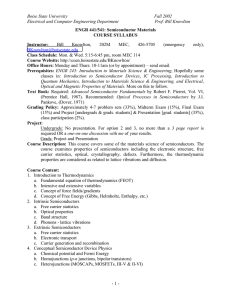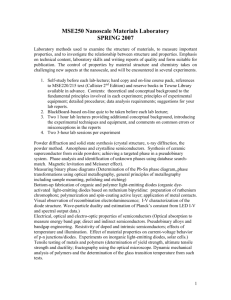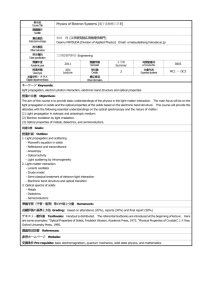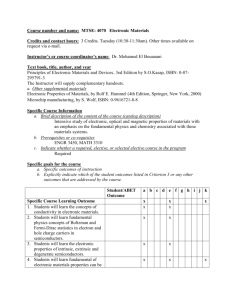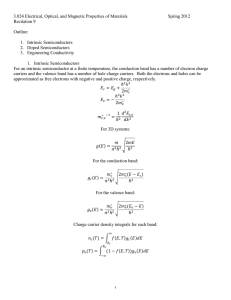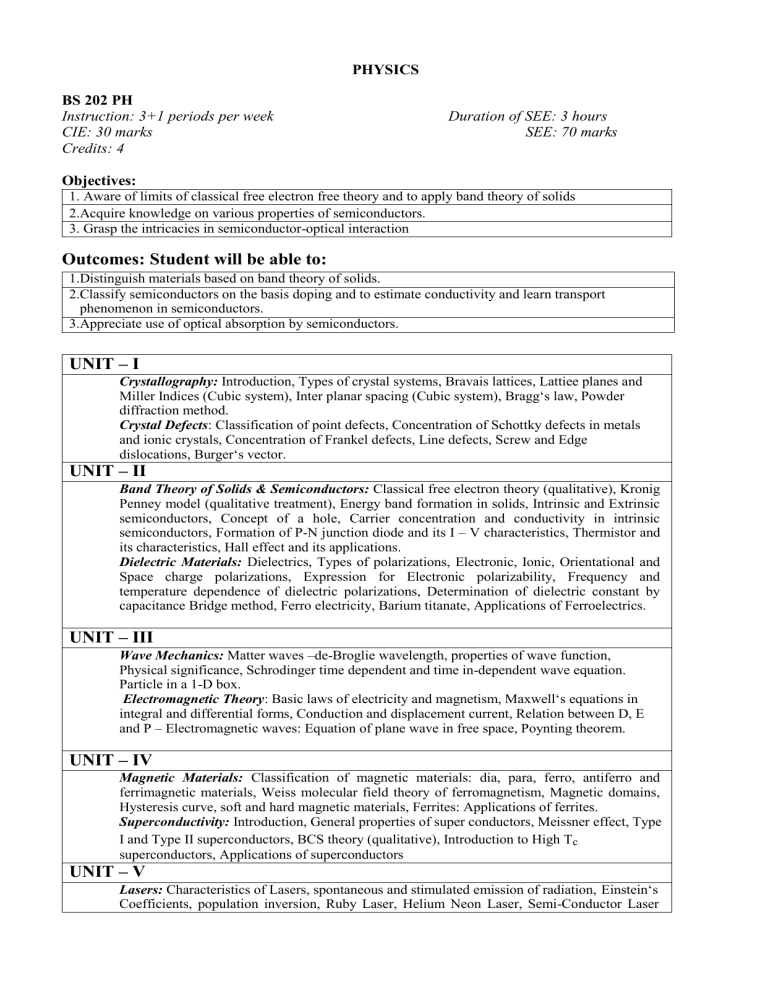
PHYSICS BS 202 PH Instruction: 3+1 periods per week CIE: 30 marks Credits: 4 Duration of SEE: 3 hours SEE: 70 marks Objectives: 1. Aware of limits of classical free electron free theory and to apply band theory of solids 2.Acquire knowledge on various properties of semiconductors. 3. Grasp the intricacies in semiconductor-optical interaction Outcomes: Student will be able to: 1.Distinguish materials based on band theory of solids. 2.Classify semiconductors on the basis doping and to estimate conductivity and learn transport phenomenon in semiconductors. 3.Appreciate use of optical absorption by semiconductors. UNIT – I Crystallography: Introduction, Types of crystal systems, Bravais lattices, Lattiee planes and Miller Indices (Cubic system), Inter planar spacing (Cubic system), Bragg‘s law, Powder diffraction method. Crystal Defects: Classification of point defects, Concentration of Schottky defects in metals and ionic crystals, Concentration of Frankel defects, Line defects, Screw and Edge dislocations, Burger‘s vector. UNIT – II Band Theory of Solids & Semiconductors: Classical free electron theory (qualitative), Kronig Penney model (qualitative treatment), Energy band formation in solids, Intrinsic and Extrinsic semiconductors, Concept of a hole, Carrier concentration and conductivity in intrinsic semiconductors, Formation of P-N junction diode and its I – V characteristics, Thermistor and its characteristics, Hall effect and its applications. Dielectric Materials: Dielectrics, Types of polarizations, Electronic, Ionic, Orientational and Space charge polarizations, Expression for Electronic polarizability, Frequency and temperature dependence of dielectric polarizations, Determination of dielectric constant by capacitance Bridge method, Ferro electricity, Barium titanate, Applications of Ferroelectrics. UNIT – III Wave Mechanics: Matter waves –de-Broglie wavelength, properties of wave function, Physical significance, Schrodinger time dependent and time in-dependent wave equation. Particle in a 1-D box. Electromagnetic Theory: Basic laws of electricity and magnetism, Maxwell‘s equations in integral and differential forms, Conduction and displacement current, Relation between D, E and P – Electromagnetic waves: Equation of plane wave in free space, Poynting theorem. UNIT – IV Magnetic Materials: Classification of magnetic materials: dia, para, ferro, antiferro and ferrimagnetic materials, Weiss molecular field theory of ferromagnetism, Magnetic domains, Hysteresis curve, soft and hard magnetic materials, Ferrites: Applications of ferrites. Superconductivity: Introduction, General properties of super conductors, Meissner effect, Type I and Type II superconductors, BCS theory (qualitative), Introduction to High Tc superconductors, Applications of superconductors UNIT – V Lasers: Characteristics of Lasers, spontaneous and stimulated emission of radiation, Einstein‘s Coefficients, population inversion, Ruby Laser, Helium Neon Laser, Semi-Conductor Laser and applications of lasers. Fiber Optics: Introduction, Propagation of light through an optical fiber, Acceptance angle, Numerical aperture (NA), Types of Optical fibers and Refractive index profiles, Fiber drawing process (double Crucible Method), Losses in optical fibers, applications of optical fibers. Suggested Readings: 1 2 3 4 5 6 B.K. Pandey and S. Chaturvedi,‖ Engineering Physics‖, Cengage Learning, 2012 A.K. Bhandhopadhya, ―Nano Materials‖, New Age International, 1st Edition, 2007 M.S. Avadhanulu and P.G. Kshirusagar,‖ Engineering Physics‖, S. Chand & Co. 1st Edition,1992 C.M. Srivastava and C. Srinivasan , ―Science of Engineering Materials‖, New Age International, 2001 R.K Gaur and S.L Gupta, ―Engineering Physics‖, McGraw-Hill Education (India) Pvt Limited, 1992 Sanjay D Jain and Girish G Sahasrabudhe, ―Engineering Physics‖, Orient Black swan Pvt Limited, 2016 PHYSICS LAB BS 251 PH Instruction:3 periods per week CIE: 25 marks Credits: 1.5 Duration of SEE: 3 hours SEE: 50 marks Objectives: 1. Make precise measurements using basic physical principles and acquire skills to handle the instruments 2. Relates the theoretical Knowledge to the behavior of Practical Physical world 3.Analyse errors in the experimental data 4.Plot graphs between various physical parameters Outcomes: Student will be able to: 1.Conduct experiments, take measurements independently 2. Write appropriate laboratory reports 3.Compute and compare the experimental results and draw relevant conclusions 4.Use the graphical representation of data and estimate results from graphs List of Experiments: 1. To determine the Dielectric constant and Phase transition temperature of Lead Zirconium Titanate (PZT). 2. To draw the I - V Characteristics of P-N Junction diode and to evaluate the resistance. 3. To find the values of Electrical conductivity and energy gap of Ge crystal. 4. Determination of rigidity of modulus of Torsion pendulum. 5. Determination of carrier concentration, Mobility and Hall Coefficient of Ge crystal using Hall Effect Experiment. 6. To determine the constants of A, B and α using Thermistor characteristics. 7. To draw the curve between the magnetizing field and the intensity of magnetization of the specimen (soft iron rod) and to find out i) Coercivity ii) Retentivity and iii) Hysteresis loss. 8. To draw the I - V Characteristics of a solar cell and to calculate the i) Fill factor Efficiency and ii) Series resistance. 9. To Determine the Numerical Aperture (NA) of Optical fiber. 10. To determine the wave length of the given Laser source. Note: Minimum eight experiments should be conducted in the semester Suggested Readings: 1 N.K. De, ―Basic Electrical Engineering‖, Universities Press, 2015 J.B. Gupta, ―Fundamentals of Electrical Engineering and Electronics‖ S.K. Kataria & 2 Sons Publications, 2002 J.B. Gupta, ―Utilization of Electric Power and Electric Traction‖ S.K. Kataria & Sons 3 Publications, 2010
